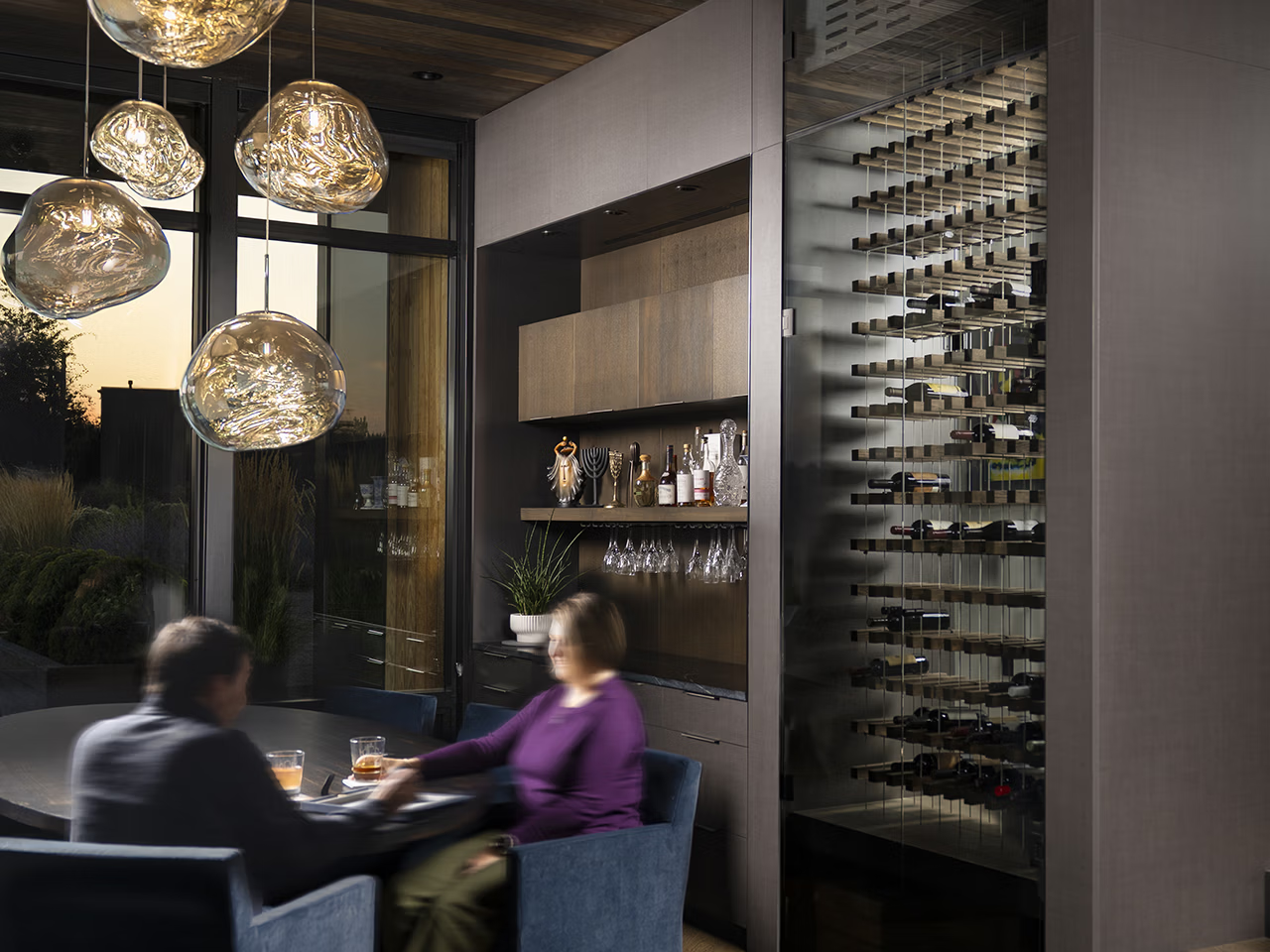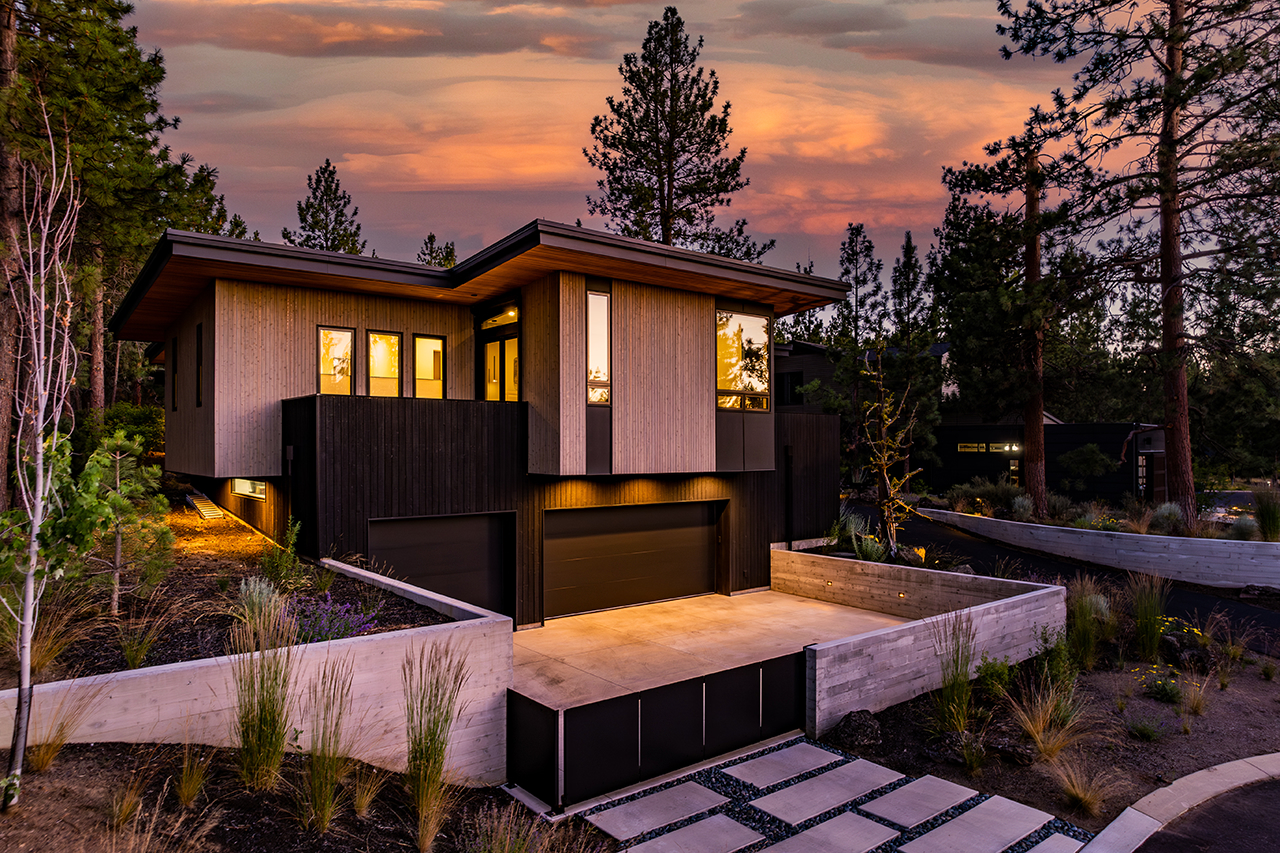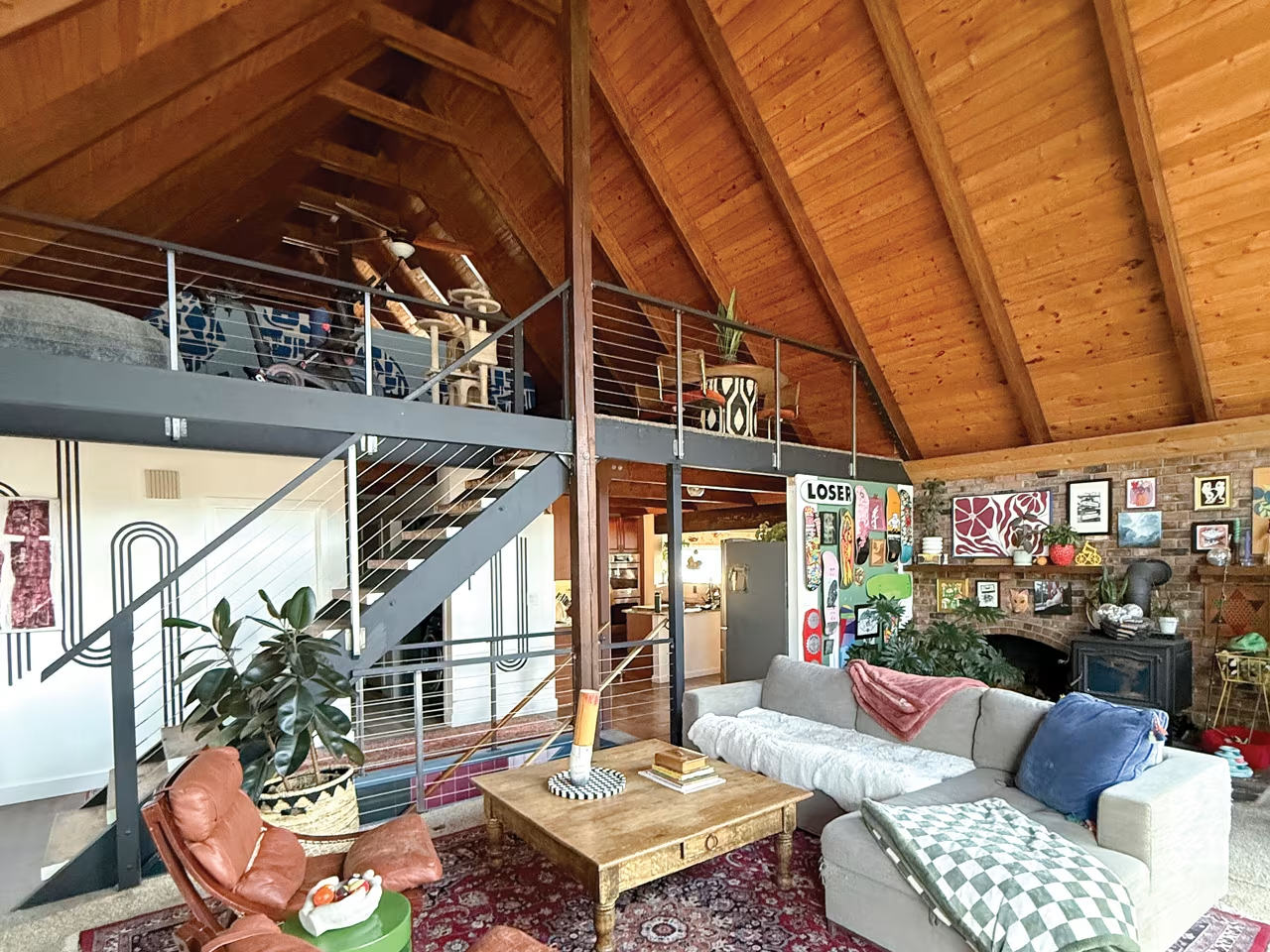Michael “Mike” and Kathryn “Kat” Burn make it a point to look at things differently. Take their home, for example. It’s constructed of prefabricated panels rarely seen in custom-home neighborhoods. Then there’s the design—eight rectangular rooms arranged around a central courtyard in the shape of a hashtag, earning it the name “Octothorpe House.”
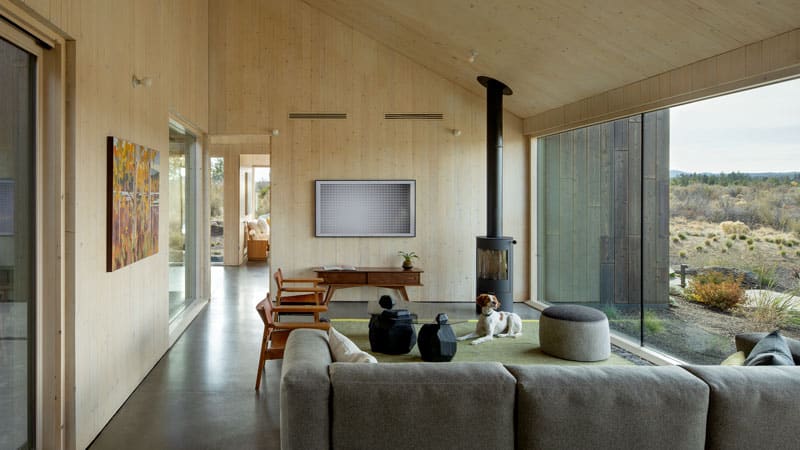
The design came from award-winning Mork-Ulnes Architects of San Francisco and Oslo, Norway, who previously had designed a remodel for the couple’s San Francisco home. The Burns felt the Mork-Ulnes team would embrace the challenge of designing an almost entirely wood home in Bend with many sustainability features. They wanted something different from the status quo and had three requests for the architects: it should be made of panels, it should be as small as possible given minimum square-footage requirements in their residential development, and it should have a courtyard as a refuge from Central Oregon’s wind.
The Move to Central Oregon in 2018
The couple moved to Central Oregon in 2018 for the lifestyle and for more time in the outdoors with their son Alan, now age 9. Both worked in the Bay Area for many years, Kat in pharmaceutical development, and Mike as the owner of a consulting company focused on innovation systems. Mike grew up in Newcastle, England, and was familiar with panel-built homes. He wanted “a stronger, more robust, high-quality house with better insulation, airtightness and fire resistance,” he said. Both Burns felt they had a moral responsibility to build with sustainable materials.
The walls and ceiling are made of cross-laminated timber (CLT) panels manufactured by SmartLam North American of Columbia Falls, Montana—one of a handful of U.S. factories producing them. Some of the CLT was made from salvaged lodgepole “blue pine” lumber killed by mountain beetles.
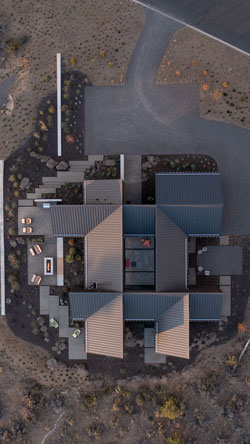
The product is made by compressing and gluing layers of solid wood in a cross pattern, which endows it with exceptional strength compared to traditional stud-framed walls. It is widely used throughout Europe and is gaining popularity in the United States
for mid- and high-rise commercial buildings as well as residential.
Building outside of standard practices had its challenges. For starters, the home is built from the inside out. “You assemble it like a Lego house,” said builder Trevor Downing, who found it difficult to find subcontractors willing to learn this new style of construction. He ended up doing much of the work himself, including the siding. “Trevor and his subs had to reinvent the wheel, no small feat,” said Casper Mork-Ulnes, founder of Mork-Ulnes Architects.
The interior wall panels arrived from the factory with windows and other holes precut. Four inches thick, the room-size panels are so heavy a crane was needed to lift and place them on the foundation. Once in place, utilities such as electrical were placed on the outside of the panels and pulled through to the interior walls. A sticky, self-adhering spray insulation was added before plywood went on to make the dwelling airtight.
In a nod to the Awbrey Hall fire that burned through Bend’s westside in 1990, the homeowners chose a burned cedar wood product called Shou sugi ban for the exterior siding. Originating from Japan, the process of burning and charring the wood makes the product waterproof, and resistant to fire, decay and insects, plus it requires almost no maintenance over the years.
Thoughtful Use of Space
“The greenest part of our home is the part we didn’t build,” Mike said. The couple met the minimum of 2,800 square feet of living space required by their residential development, even though it was larger than what they wanted for their one-story home. “It was exciting for us to work with American clients who didn’t necessarily want a mega-mansion. In Europe we’re used to being economical with space,” Mork-Ulnes said. “There’s not a square inch of wasted space,” Kat said. “Everything is useful living space.”
The design team paid particular attention to where the house sat on the site. “It was about not filling up the entire lot,” she said. “It was about placing it in the right position for views and privacy, making the most of the space.”
The hashtag design of rooms around the courtyard includes a large rectangular space consisting of the living and dining rooms, kitchen and a large butler’s pantry (also known in Britain as a “dairy room with storage”). Each room flows into the next, negating the need for hallways.
The four bedrooms have ensuite bathrooms, with the primary suite slightly larger than the other rooms. An office for the work-from-home-couple doubles as a guest bedroom with a hidden Murphy bed. Each room has a door to the courtyard and another door leading to a patio or the natural environment. Inhabitants can easily cross between rooms through the center courtyard or via interior spaces. This crisscross pattern of open doors also lends itself to cross ventilation of fresh air on hot days. Large eight-by-eight-foot windows in every room convey light and connect people on the inside with the outside landscape.
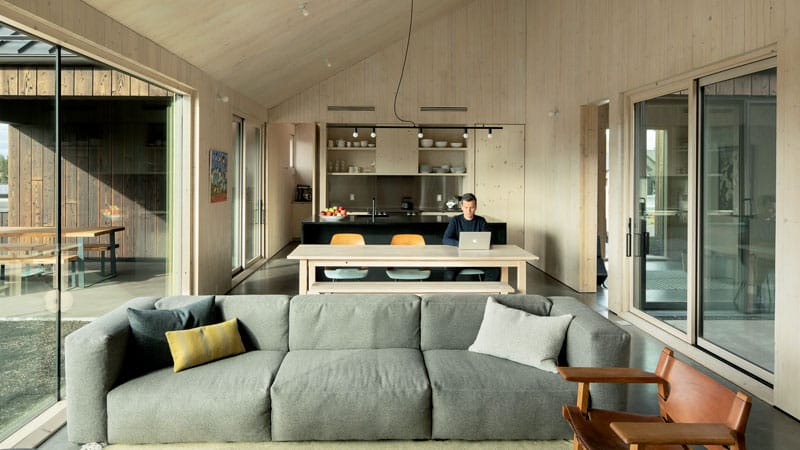
Windows to the exterior of the home and interior courtyard bring in light and breezes on warm days.
Because the walls and roof were prefabricated and panels had to fit perfectly with one another, architectural drawings were extensive and specified every aspect of construction. “They were some of the most detailed plans I’ve ever seen,” Downing said. “There must have been one-hundred pages which laid out everything from strict guidelines for CLT installation to tile design and bathroom fixtures. Having a plan that detailed helped a ton.” And because of the extraordinary “tightness” of construction, walls and windows required no trim to cover rough or uneven edges.
Modern Design Meets the High Desert
The wood panels made of pine, spruce and fir imbue the home with a warm, Scandinavian chalet feel. There’s no sheetrock or painted surface anywhere in the house. The high insulation values, thick walls and windows dampen sound and give spaces a quiet coziness. “The acoustics are great,” Kat said.
“The beautiful high desert environment and the sculptural design of the house drew us toward [the design aesthetics of] Donald Judd’s Chinati Foundation in Marfa, Texas,” said Lexie Mork-Ulnes, interior designer. She said the two dominant materials in Octothorpe—the CLT and the concrete floors—inspired a muted color palette for furniture, surfaces and fixtures that would merge with the natural landscape. Furnishings are made of wool, felt and leather.
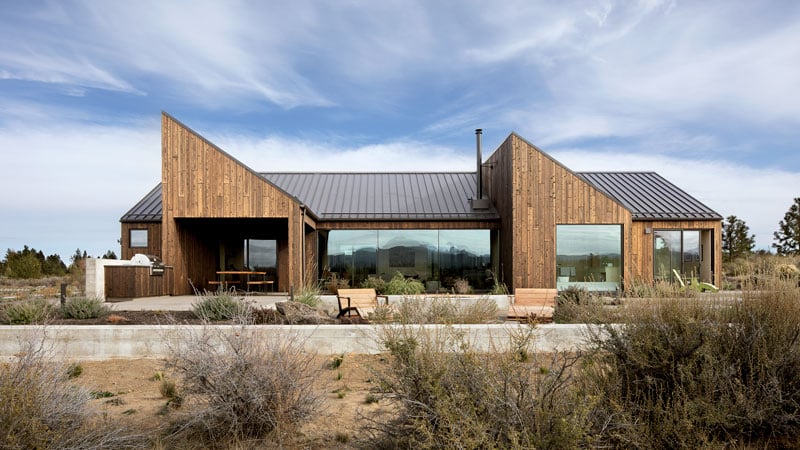
A unique coffee table in the living room crafted by Oakland wood artist Yvonne Mouser was inspired by the Three Sisters peaks visible from the sofa. She used a chainsaw and blow torch on three Douglas fir blocks to create three peaks that protrude through smoked glass to mimic the view.
The public part of the kitchen is sleek and uncluttered with a black paper-stone island. It’s the only dark feature in the great room except for a black Danish wood-burning stove in the living room. Cabinets hold a discreet induction stove and dishwasher. The tidy kitchen hides a walkaround pantry where no cook’s tool was overlooked. It has a commercial-grade stainless steel sink, two refrigerators and freezers, shelving for appliances and dry goods and extensive counters for food prep and cabinetry for storage.
“God is in the details,” said Casper Mork-Ulnes. “The initial concept is as important as the final details and execution. We had to think it through and design every little thing. We picked everything from the toilet paper holder to recessed door handles and light switches.”
Dustin Moore of San Francisco-based Strata Landscape Architecture worked with Mork-Ulnes from the beginning to ensure consistency between the house and the landscape. The space immediately surrounding the building is populated with native plants that require little water and hardscapes such as concrete steps leading to a gas fire pit and a covered outdoor dining and barbeque area.
Mike describes himself and Kat as compulsively committed. “If you’re going to build something, build something epic,” he said. After two years of living in the house, the couple feels they accomplished their goal. “We have this house, and we can walk right into the forest. I have to pinch myself.”
Resources:
Architect: Casper Mork-Ulnes | Interior designer: Lexie Mork-Ulnes | Builder: Trevor Downing | Landscape: Dustin Moore, Strata Landscape Architecture | Engineering: Eclipse Engineering

